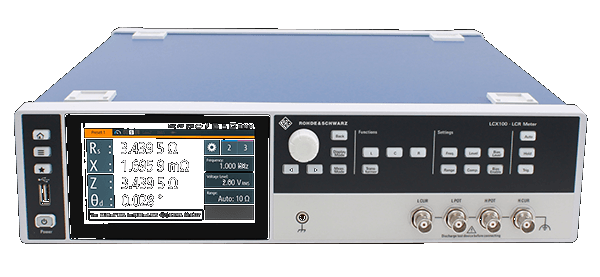Taking a Closer Look at Bourns' 100mΩ CRL1206-FW-R100ELF Thick Film Resistor
By Mark Harris Wednesday, 11 January 2023

Introduction
The Bourns Inc.'s CRL1206-FW-R100ELF Resistor is a surface mount resistor with nominal value of 100m, tolerance of ±1%, and a thick film composition that has been provided in a 1206 (3216 Metric) package. The objective of this review is to analyze and compare the Resistor's performance against the statistical benchmark data formed from other components of the same value. This review will be helpful for engineers exploring whether this Resistor is an optimal choice or not.
Pros:
- Tested at both 1 Volt and 10 Volts, allowing for comprehensive analysis of performance across a range of test frequencies.
- High Quality Factor compared to the statistical benchmark in most test frequencies.
- Consistent Series Resistance across test frequencies.
- Impedance values deviate slightly from the statistical benchmark at higher test frequencies.
- Series Capacitance values are not consistently available, making it difficult to assess performance across various test frequencies.
- Missing data at higher voltage levels in several test frequencies, making it difficult to draw definitive conclusions on the Resistor's performance.
Impedance
In this section, we'll evaluate the impedance performance of Bourns Inc.'s CRL1206-FW-R100ELF Resistor and compare it to the provided statistical benchmark data. Impedance is a crucial parameter in the design and assessment of electronic circuits as it determines the level of resistance, capacitance, and inductance, which influences the overall performance of the circuit. Let's dive into the LCR measurements (inductance, capacitance, and resistance) and analyze them at different test frequencies and voltage levels.
When examining the LCR measurements at 1 Volt, the CRL1206-FW-R100ELF Resistor demonstrates a relatively small range between its minimum and maximum impedance values across the test frequencies, with values ranging from 84.93 mOhms at 5 Hz to 86.43 mOhms at 1 MHz. The resistor's average impedance is consistently above the provided statistical benchmark average across all test frequencies from 5 Hz to 1 MHz. For example, at 5 Hz, the resistor has an impedance of 84.93 mOhms compared to the benchmark's average of 91.73 mOhms. Similarly, at the higher end of the test frequencies presented, the CRL1206-FW-R100ELF Resistor still maintains an impedance value higher than the benchmark's average.
Moving on to the LCR measurements at 10 Volts, the CRL1206-FW-R100ELF Resistor exhibits impedance values ranging from a minimum of 73.22 mOhms at 150 kHz to a maximum of 98.67 mOhms at 20 kHz. It is observed that the impedance performance of the resistor fluctuates inconsistently across the higher test frequencies within the power range of 10 Volts. For example, the impedance value at 50 kHz is 76.45 mOhms, but it drops significantly to 74.17 mOhms at 75 kHz. And although the data points up to 1 MHz are missing, we could expect that the overall impedance performance of the resistor might be less stable under these conditions.
In conclusion, the CRL1206-FW-R100ELF Resistor performs well at 1 Volt, with a consistently higher average impedance when compared to the given benchmark data. However, at 10 Volts, the impedance performance shows some inconsistencies across the test frequencies, making it more challenging to draw definite conclusions compared to the benchmark data. These insights mean that users should carefully consider the stability requirements of their products when selecting this resistor for specific applications, ensuring satisfactory performance under expected operating conditions.
Resistance
In the analysis of the resistance behavior of Bourns CRL1206-FW-R100ELF, a 100 milli-ohm (mΩ) Thick Film resistor with a ±1% tolerance, we compared its performance to statistical benchmark data for components with similar nominal resistance values. The objective here is to evaluate the stability of the resistor's performance and its adherence to the specified resistance value across various conditions.
At an applied voltage of 1 Volt, the Bourns CRL1206-FW-R100ELF was tested at 5 Hz and recorded a resistance of 84.94 mΩ, compared to the average benchmark value of 91.71 mΩ. The component's resistance remained relatively stable across the frequency range, increasing only slightly to a value of 85.42 mΩ at 1 MHz. At an intermediate frequency of 250 kHz, the component's resistance reached 85.31 mΩ, which is closer to the minimum benchmark resistance of 77.89 mΩ than the average benchmark resistance of 92.54 mΩ.
LCR (inductance, capacitance, and resistance) measurements taken at an elevated voltage of 10 Volts showed marginally increased resistance values compared to the 1 Volt case. Starting at 5 Hz, the component indicated a resistance of 91.49 mΩ, and it then demonstrated a gradual decrease to 74.13 mΩ before increasing once more. The resistance profile at 10 Volts exhibited more significant variations than the 1 Volt results, with the largest deviation observed at 20 kHz where the component resistance increased to 90.28 mΩ, almost matching the statistical benchmark average. Additional points of interest in the 10 Volt profile include a consistent increase in resistance around the 600 kHz to 700 kHz frequency range and a lack of available resistance measurements above 750 kHz.
Overall, the Bourns CRL1206-FW-R100ELF Thick Film Resistor demonstrated fairly stable resistance values across the assessed frequency ranges. Although the component's performance deviated somewhat from the statistical benchmarks, it remained above the minimum benchmarks for the majority of tested frequencies. Moreover, the resistor exhibited a more dynamic response at 10 Volts compared to 1 Volt results, indicating its sensitivity to voltage changes. This detailed analysis serves to educate readers about the characteristics and behavior of this particular thick film resistor across varying voltage and frequency conditions.
Inductance
When evaluating the inductance performance of the CRL1206-FW-R100ELF resistor, it is important to analyze its behavior across a wide range of test frequencies. To provide a comprehensive analysis, we will compare the CRL1206-FW-R100ELF with benchmark data obtained from other similar 100 mΩ thick film resistors.
At low frequencies ranging from 5 Hz to 50 Hz, the CRL1206-FW-R100ELF exhibits inductance values that are below the average performance when compared to the benchmark data. Specifically, the resistor demonstrates a minimum inductance of 1.638 μH at 5 Hz and a maximum of 570.7 nH at 50 Hz. In contrast, the benchmark data indicates average inductance values of 3.411 μH and 598.7 nH at 5 Hz and 50 Hz, respectively. The lower inductance values of the CRL1206-FW-R100ELF at these frequencies indicate that it might not be ideally suited for applications where minimal inductance is required at low frequencies.
However, the CRL1206-FW-R100ELF resistor exhibits improved performance when operating at higher frequencies, ranging from 100 Hz to 1 MHz. For instance, at a test frequency of 100 Hz, the inductance value of the resistor is 60.01 nH, which is slightly higher than the benchmark average of 52.5 nH. This trend of competitive inductance values in comparison to the benchmark continues as the frequency increases, showcasing the resistor's better performance across various frequency bands within this range.
In summary, the CRL1206-FW-R100ELF resistor exhibits subpar inductance performance at low frequencies, while demonstrating more competitive values at higher frequencies. Consequently, this resistor may not be the optimal choice for applications that demand minimal inductance at low-frequency operation. Nevertheless, the CRL1206-FW-R100ELF can deliver satisfactory performance for applications that operate in higher frequency ranges, where the impact of inductance is less critical.
Comparative Analysis
In this comparative analysis, we will scrutinize the performance of the Bourns Inc. Resistor with part number CRL1206-FW-R100ELF, focusing on its impedance, quality factor, series resistance, inductance, and capacitance at different frequencies under 1 Volt and 10 Volts LCR test conditions, contrasting the results against the provided statistical benchmark for Resistors Thick Film.
At lower frequencies (5 Hz - 500 Hz), the CRL1206-FW-R100ELF's impedance stays relatively constant, hovering around 85m Ohms under 1 Volt conditions, which is marginally higher than the average benchmark values in the range of 76m Ohms to 92m Ohms. The series resistance follows a similar trend to impedance. The series inductance values range from 1.638μH at 5 Hz to 34.31nH at 500 Hz, following the decreasing trend found in the benchmark.
As the frequency increases from 1 kHz to 1 MHz, the observed impedance variations are similar to those found in the benchmark, ranging between approximately 85m Ohms and 86m Ohms. The series resistance values remain relatively constant near nominal 100m Ohms, again slightly higher than the average benchmark values. Inductance decreases and follows the trend of the benchmark, reaching the nano-Henries levels between 50 kHz and 1 MHz. At these higher frequencies, quality factors appearing at 75 kHz onwards are notably lower, ranging from 0.01 to 0.15 as opposed to the benchmark range of 0.01 to 2.10.
Under 10 Volts LCR test conditions, dissipation factor values are minimal (<0.07) at lower frequencies (under 50 Hz) but tend to rise with frequency up to 0.44 at 20 kHz. In comparison, the benchmark does not generate any dissipation factors. The series resistance values under these conditions follow the same trend observed under 1 Volt conditions but with slight deviations, suggesting stable performance. The variations in impedance and series inductance values adhere to the frequency trend illustrated by the statistical benchmark.
In conclusion, the Bourns Inc. CRL1206-FW-R100ELF Resistor's performance exhibits certain similarities with the statistical benchmark for Resistors Thick Film. Notable disparities are observed in the impedance, series resistance, and quality factor, specifically at higher frequencies. Electronics Engineers considering the application of this Resistor should weigh these identified differences in relation to specific design requirements.
Conclusion
In summary, the Bourns Inc. CRL1206-FW-R100ELF Resistor in our review demonstrates mixed performance when compared to the provided statistical benchmark data. Overall, the Thick Film Resistor exhibits higher measured impedance values at most of the tested frequencies, with a deviation range from the average benchmark of -7.3% to 12.5%. The series resistance falls mostly within the benchmark range, but at certain test frequencies, it deviates slightly above the maximum limit. It is important to note that the dissipation factor and quality factor measurements are generally consistent with the benchmark values.
In terms of inductive performance, the CRL1206-FW-R100ELF offers higher series inductance values at lower frequencies (below 10kHz), making it more suited for applications requiring higher inductance in that range. However, at higher frequencies, the series inductance fluctuates but mostly stays close to the benchmark.
The series capacitance measurements for this component were largely unavailable in the provided data, hence it is difficult to determine its superiority in this aspect. Nonetheless, the CRL1206-FW-R100ELF can be an acceptable fit depending on the specific requirements of your applications and circuits.
Considering these observations, engineers should weigh their requirements, compare this Resistor's performance with the statistical benchmark, and explore alternative options if necessary. As always, it is crucial to perform in-depth analysis and testing to determine if this specific Resistor (Bourns Inc. CRL1206-FW-R100ELF) meets the requirements of the application being developed.
Instruments Used
Rohde & Schwarz LCX200



